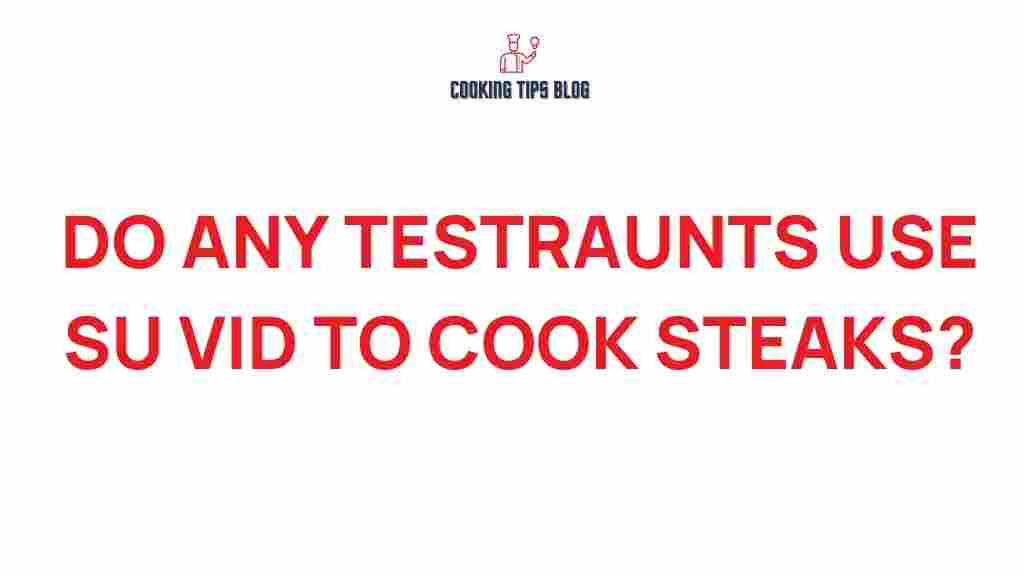Do Restaurants Really Use Sous Vide for Cooking Steaks?
When it comes to cooking steak, achieving the perfect level of doneness is a culinary challenge that many chefs face. One method that has gained significant popularity in recent years is sous vide. This technique involves vacuum-sealing food in a bag and cooking it in a water bath at a precise temperature. But do restaurants really use sous vide for cooking steaks? In this article, we will delve into the world of sous vide cooking, explore its benefits, and discuss whether this method is prevalent in restaurants.
What is Sous Vide?
Sous vide, which translates to “under vacuum” in French, is a cooking method that involves sealing food in a vacuum-sealed bag and immersing it in a water bath at a controlled temperature. This technique allows for precise temperature control, ensuring that the food cooks evenly without the risk of overcooking. The sous vide process typically follows these steps:
- Preparation: Season the steak with your choice of herbs and spices.
- Vacuum Sealing: Place the steak in a vacuum-sealed bag and remove as much air as possible.
- Water Bath Cooking: Submerge the bag in a water bath set to the desired temperature.
- Finishing Touch: After cooking, sear the steak in a hot pan or on a grill for a crispy crust.
Benefits of Using Sous Vide for Cooking Steaks
The sous vide method offers several advantages when it comes to cooking steaks:
- Precision: Sous vide allows for precise temperature control, enabling chefs to achieve the exact doneness desired, whether it be rare, medium, or well-done.
- Tenderness: Cooking steaks at lower temperatures for extended periods can result in exceptionally tender meat.
- Consistency: Sous vide ensures consistent results every time, reducing the chances of overcooking or undercooking.
- Flavor Infusion: The vacuum-sealing process helps to infuse flavors directly into the meat.
Do Restaurants Use Sous Vide for Cooking Steaks?
Many high-end restaurants and steakhouses have embraced sous vide as a method for cooking steaks. The reasons for its popularity are numerous:
- Quality Control: Restaurants strive to maintain a high standard of food quality. Sous vide allows chefs to consistently deliver perfectly cooked steaks.
- Time Efficiency: Sous vide cooking can be done in advance, allowing chefs to focus on other tasks during busy service hours.
- Menu Flexibility: Restaurants can prepare steaks ahead of time and finish them to order, ensuring maximum freshness.
However, it is worth noting that not all restaurants use sous vide. Some establishments prefer traditional cooking methods, such as grilling or broiling, to achieve a specific flavor profile or texture. Ultimately, it depends on the restaurant’s philosophy and the experience they wish to provide to their patrons.
How to Cook Steak Sous Vide at Home
If you’re intrigued by the idea of cooking steak sous vide at home, here’s a simple step-by-step guide:
- Gather Your Equipment: You will need a sous vide immersion circulator, vacuum-sealable bags, and a large pot or container for the water bath.
- Season the Steak: Season both sides of your steak with salt, pepper, and any other desired spices.
- Vacuum Seal: Place the seasoned steak in a vacuum-seal bag and remove the air using a vacuum sealer.
- Set Up the Water Bath: Fill a pot or container with water and attach the sous vide immersion circulator. Set the temperature to your desired doneness (e.g., 130°F for medium-rare).
- Cook the Steak: Submerge the vacuum-sealed steak in the water bath and cook for 1 to 4 hours, depending on the thickness of the steak.
- Finish with a Sear: Once the steak is done, remove it from the bag and pat it dry. Sear it in a hot pan or on a grill for 1-2 minutes per side to develop a crust.
Troubleshooting Tips for Sous Vide Cooking
While sous vide is a relatively straightforward cooking method, you may encounter some challenges. Here are some troubleshooting tips:
- Steak is Overcooked: Make sure to monitor the cooking time and temperature closely. If you’re unsure, use a meat thermometer to check the internal temperature.
- Bag Leaks: Ensure that the vacuum-sealing process is done correctly. Double-bagging can help prevent leaks.
- Flavor Issues: Experiment with different seasonings and marinades to enhance the flavor of your steak.
Common Myths About Sous Vide Cooking
Despite its growing popularity, there are several myths surrounding sous vide cooking:
- Myth 1: Sous vide cooking is only for professional chefs.
Reality: Anyone can learn to cook sous vide at home with the right equipment and guidance. - Myth 2: Sous vide makes food taste bland.
Reality: Proper seasoning and marinating can enhance flavors significantly. - Myth 3: Sous vide cooking takes too long.
Reality: While the cooking time can be longer, the hands-on time is minimal, allowing for multitasking.
Conclusion
So, do restaurants really use sous vide for cooking steaks? The answer is yes, many do! This innovative cooking method offers precision, consistency, and the ability to produce tender, flavorful steaks that meet high culinary standards. While some restaurants may prefer traditional methods, the sous vide technique has carved its niche in the culinary world.
If you’re looking to elevate your home cooking game, experimenting with sous vide cooking can be a rewarding experience. With the right equipment and techniques, you can achieve steak perfection in your own kitchen.
For more information on sous vide cooking and recipes, check out this resource. If you’re interested in buying sous vide equipment, consider visiting this site for more options.
This article is in the category Tools and created by Cookingtipsblog Team
